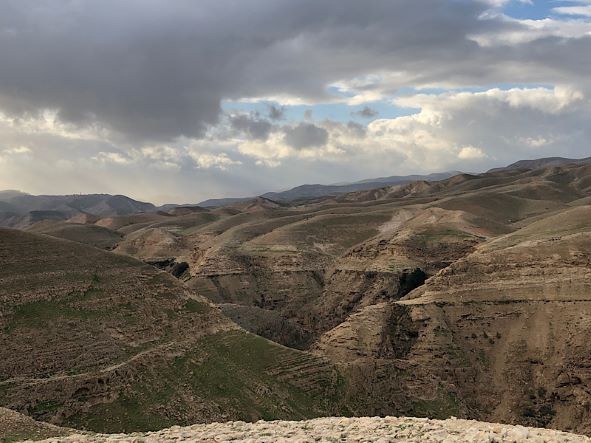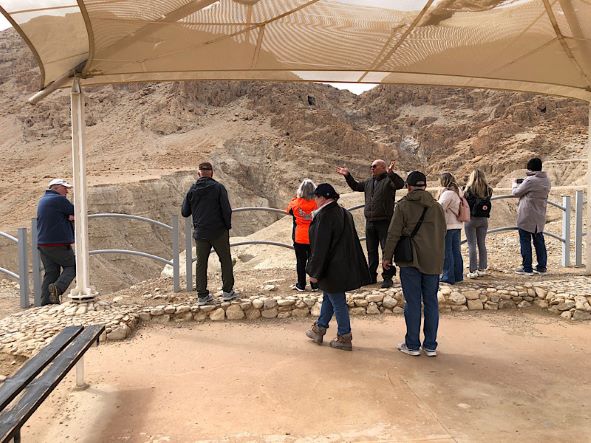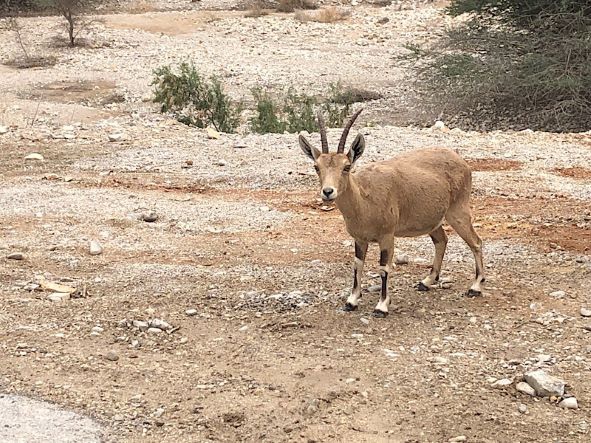Our start to an adventurous day in the Holy Land was a visit to the site connected with John’s baptism of Jesus (Matt 3; Mark 1; Luke 3), or Beth Aravah. George, our guide, talked about John’s baptism, then we took some personal time to remember our own baptism and to give thanks. This was a great opportunity to interact directly with the waters of the Jordan River.
We visited Jericho next and stood on the famous tell (mound) where the walls came down in Joshua 6. Thousands of years were layered under our feet—there is a Neolithic tower foundation that dates to 8,000 BC! We learned why Jericho was so significant and why the Israelites entered the land there. God did powerful, miraculous things there and called on Joshua and the people to be faithful. We had some brief devotional moments discussing the lead-in to the conquering of Jericho in Joshua 5.
From Old Testament Jericho we could see the mountains to the west, and somewhere among them Jesus was tempted by the devil (Matt 4; Mark 1; Luke 4). Modern Jericho is nearby, and as we drove through, we saw an old sycamore tree and talked about Zacchaeus climbing a similar tree on a day that changed his life (Luke 19).
We headed south toward the Dead Sea for a visit to the archaeological site of Qumran, which is associated with the community responsible for the Dead Sea Scrolls. ُThis is a fascinating place where a Jewish sect chose to separate from what they believed was a corrupt faith in Jerusalem. They went to the wilderness along the shore of the Dead Sea to live, produce copies of the Hebrew Bible and other religious literature of their sect, and wait for the Messiahs. Yes, they anticipated two Messiahs: a Messiah-king, and a priestly Messiah. In addition to discussing the people, we learned about the Dead Sea Scrolls and why they are important to the study of the Bible.
We were already close to the Dead Sea, but we got even closer as we drove to a beach location that allowed us to get right up to the shore of that beautiful but unusual body of water. We have now been able to be up close and to interact with the Mediterranean Sea, the Jordan River (including its headwaters), the Sea of Galilee, and the Dead Sea—all four of the major bodies of water in the Holy Land.
Finally, it was time to head to Jerusalem, where we are staying the night in anticipation of two full days in the ancient holy city. On the way, we paused at Wadi Qilt to see the “road to Jericho” of the Good Samaritan story (Luke 10). Looking at the road and the terrain, it was easy to visualize the dangers of that route that the story depicts, and other details of that parable make sense when we understand its setting. The deep ravine (wadi) that the road follows from Jerusalem to Jericho is thought to be “the valley of the shadow of death” mentioned in Psalm 23:4. It’s a scary, dangerous chasm that certainly puts that verse into perspective.
We look forward to the next few days as we explore sites like the Temple Mount, the Western Wall, the Mount of Olives, the Garden of Gethsemane, the Pool of Bethesda, and much more.






